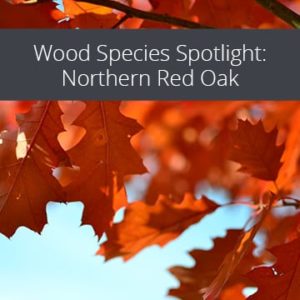
Appearance
Usually just called “red oak,” this domestic hardwood tends to be warm and on the lighter side. Like its name, it often has pink or red undertones. As it ages, it darkens to golden brown or even amber in color. The pronounced, attractive grain is mostly straight and thin, with some rippling, and is slightly rough in texture. Unlike many woods species, there is often less color contrast between the sapwood, or outer wood, and the inner heartwood. For this reason, it is easy to match planks when evenness and consistency is desired.
Availability
Native to North America, red oak is one of the most abundant species of hardwood in the United States, which contributes to its popularity. According to the American Hardwood Information Center, it accounts for about one-third of the domestic hardwood market. It grows quickly for a hardwood – up to two feet or more in height per year. Abundance and ready availability make it a sustainable material with a low carbon footprint. It is moderately priced, and slightly cheaper than its popular American relative, the white oak.
Durability
Red oak is a hard, porous wood. On the Janka scale, which measures the hardness of wood species, it has a rating of 1290, putting it on the harder end of the spectrum. It is easier to work with, both by hand and with machines, than higher-rating species such as hickory or mahogany. This also helps account for its relatively low cost and its popularity with woodworkers. Red oak is not recommended for outdoor applications, as it will warp easily with prolonged exposure to the elements.
Maintenance
It is important to remember that, while oak is a hardwood, it is still wood. It will scratch and mar, so care must be taken to prevent damage to high traffic areas such as entryways and hallways. Avoid exposure to large quantities of water. Red oak’s porous fibers make it especially susceptible to humidity levels. Using a humidifier to regulate humidity levels will help keep floors in good condition. Applying a finish will also help extend the life of your floors. Red oak takes finish easily and evenly.
Made in America
There are many factors that make red oak the most popular choice for wood flooring in the United States: its availability, its cost, its durability, its sustainability, and its natural beauty. And as this species is native to North America, there is some comfort in knowing that one of the most striking features of your home was grown here, at home. So for a traditional look, go with an American classic.
At Oshkosh Designs, we know that your investment in wood flooring is a big decision. We want you to be happy with your choice for years to come. As with all big investments, the more you learn about it beforehand, the more confident you will feel that you’ve made the right choice.



